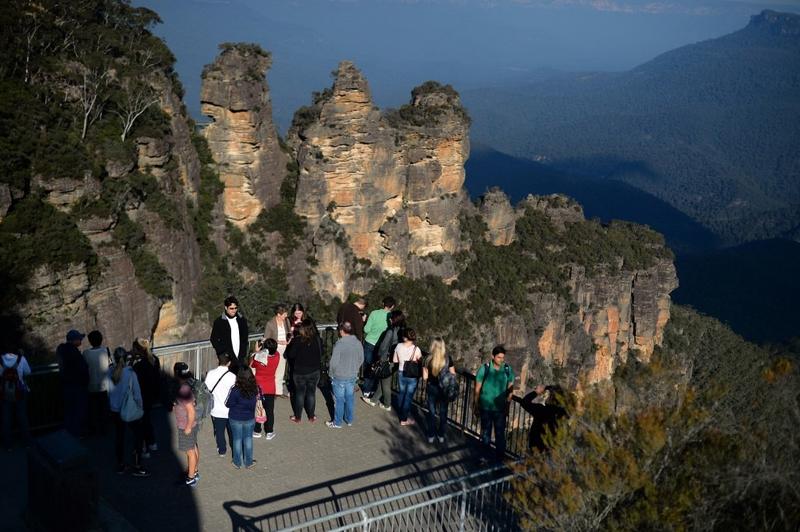 In this picture taken on May 12, 2013, people visit the 'Three Sisters' rock formation in the Blue Mountains. The Blue Mountains is a mountainous region in New South Wales, some 50 kilometers west of Sydney. (SAEED KHAN / AFP)
In this picture taken on May 12, 2013, people visit the 'Three Sisters' rock formation in the Blue Mountains. The Blue Mountains is a mountainous region in New South Wales, some 50 kilometers west of Sydney. (SAEED KHAN / AFP)
KATOOMBA, Australia - Sparse handfuls of people stand at railings to gaze at plunging rocks and shimmering waterfalls amid the verdant vegetation of Australia’s Blue Mountains, presenting a stark contrast with the throngs usually drawn to the attraction every year.
The operator of the world’s steepest railway and glass floored cable cars says its nature park is nearly empty as Australia’s border closures over the coronavirus will keep out the annual influx of Lunar New Year tourists this year.
Normally, during Chinese New Year, we would be absolutely bustling with all our delightful visitors from across Asia. But this year we’ve seen a really significant, absolutely complete decline.
Anthea Hammon, chief executive of privately-owned Scenic World, railway and cable car operator in the Blue Mountains
“Normally, Chinese New Year we would be absolutely bustling with all our delightful visitors from across Asia,” said Anthea Hammon, the chief executive of privately-owned Scenic World, now open just four days a week, from seven formerly.
“We’ve seen a really significant, absolutely complete decline.”
Koreans, numbering about 250,000, made up the biggest group of international visitors before Australia closed its borders, Hammon said, while another 230,000 came from China, closely followed by groups from Japan and Taiwan.
ALSO READ: Global tourism recovery faces grave challenges
The domestic market will not make up for the revenue lost from the more than 600,000 international visitors to the attraction each year, she added, and other tourism operators agreed.
“Right now we are only operating one day a week and we’re probably lucky to have 10 passengers a day, on that one day,” said Jason Cronshaw, the owner of the Blue Mountains Explorer Bus Company.
His buses would probably carry 8,000 passengers over the usual Lunar New Year period, Cronshaw told Reuters, as he rode the top deck of an empty one.
He added that the absence of spending by Asian tourists was hurting the entire scenic area near Australia’s biggest city of Sydney.
 Tourists visit Mount Wilson to see autumn leaves along the road in the Blue Mountains region in Australia on May 22, 2016. (SAEED KHAN / AFP)
Tourists visit Mount Wilson to see autumn leaves along the road in the Blue Mountains region in Australia on May 22, 2016. (SAEED KHAN / AFP)
“They would, of course, spend extra visiting Scenic World, going to the local restaurants and cafes, and some of them also staying overnight in the Blue Mountains during that Chinese New Year period, and that again is all but gone,” he added.
Still, some people in the area are relieved to see fewer tourists.
At the Echo Point lookout, which offers sweeping views of the Blue Mountains and the Three Sister rock formation for free, some locals posed for pictures with a few domestic visitors.
“It’s been quite a relief just to have a bit of quiet time and enjoy the mountains environment without so many tourists,” decade-long resident Louise Bennett said.
Australia closed its borders last March to all but citizens and permanent residents who face two weeks in mandatory hotel quarantine on arrival at their own expense.
READ MORE: UN agency: 2020 was worst year in tourism history
Its tally of just under 29,000 infections, with 909 deaths, is fa fewer than many other developed countries, thanks to tough border controls, widespread testing, social distancing rules and lockdowns.


